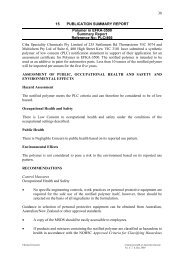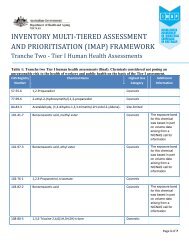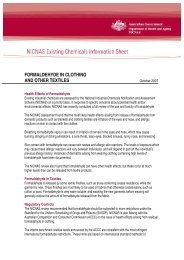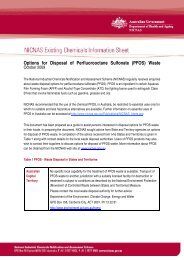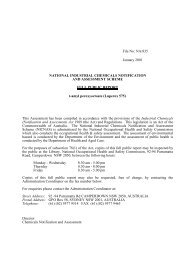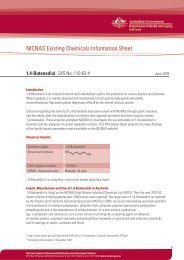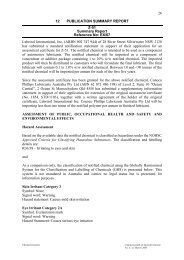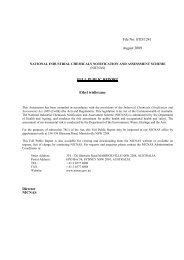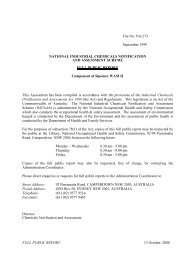MIPA-Laureth sulfate - NICNAS
MIPA-Laureth sulfate - NICNAS
MIPA-Laureth sulfate - NICNAS
Create successful ePaper yourself
Turn your PDF publications into a flip-book with our unique Google optimized e-Paper software.
File No: STD/1047<br />
June 2004<br />
NATIONAL INDUSTRIAL CHEMICALS NOTIFICATION AND ASSESSMENT SCHEME<br />
(<strong>NICNAS</strong>)<br />
FULL PUBLIC REPORT<br />
<strong>MIPA</strong>-<strong>Laureth</strong> <strong>sulfate</strong><br />
This Assessment has been compiled in accordance with the provisions of the Industrial Chemicals (Notification and<br />
Assessment) Act 1989 (Cwlth) (the Act) and Regulations. This legislation is an Act of the Commonwealth of Australia.<br />
The National Industrial Chemicals Notification and Assessment Scheme (<strong>NICNAS</strong>) is administered by the Department of<br />
Health and Ageing, and conducts the risk assessment for public health and occupational health and safety. The<br />
assessment of environmental risk is conducted by the Department of the Environment and Heritage.<br />
For the purposes of subsection 78(1) of the Act, this Full Public Report may be inspected at:<br />
Library<br />
National Occupational Health and Safety Commission<br />
25 Constitution Avenue<br />
CANBERRA ACT 2600<br />
AUSTRALIA<br />
To arrange an appointment contact the Librarian on TEL + 61 2 6279 1161 or + 61 2 6279 1163.<br />
This Full Public Report is available for viewing and downloading from the <strong>NICNAS</strong> website or available on request, free<br />
of charge, by contacting <strong>NICNAS</strong>. For requests and enquiries please contact the <strong>NICNAS</strong> Administration Coordinator at:<br />
Street Address: 334 - 336 Illawarra Road MARRICKVILLE NSW 2204, AUSTRALIA.<br />
Postal Address: GPO Box 58, SYDNEY NSW 2001, AUSTRALIA.<br />
TEL: + 61 2 8577 8800<br />
FAX + 61 2 8577 8888<br />
Website: www.nicnas.gov.au<br />
Director<br />
Chemicals Notification and Assessment
TABLE OF CONTENTS<br />
FULL PUBLIC REPORT ....................................................................................................................................... 3<br />
1. APPLICANT AND NOTIFICATION DETAILS....................................................................................... 3<br />
2. IDENTITY OF CHEMICAL ...................................................................................................................... 3<br />
3. COMPOSITION ......................................................................................................................................... 4<br />
4. INTRODUCTION AND USE INFORMATION........................................................................................ 4<br />
5. PROCESS AND RELEASE INFORMATION .......................................................................................... 4<br />
6. PHYSICAL AND CHEMICAL PROPERTIES ......................................................................................... 6<br />
7. TOXICOLOGICAL INVESTIGATIONS .................................................................................................. 7<br />
8. ENVIRONMENT ..................................................................................................................................... 11<br />
9. RISK ASSESSMENT ............................................................................................................................... 13<br />
10. CONCLUSIONS – ASSESSMENT LEVEL OF CONCERN FOR THE ENVIRONMENT AND<br />
HUMANS ......................................................................................................................................................... 14<br />
11. MATERIAL SAFETY DATA SHEET................................................................................................. 14<br />
12. RECOMMENDATIONS ...................................................................................................................... 15<br />
13. BIBLIOGRAPHY................................................................................................................................. 15
June 2004 <strong>NICNAS</strong><br />
FULL PUBLIC REPORT<br />
<strong>MIPA</strong>-<strong>Laureth</strong> <strong>sulfate</strong><br />
1. APPLICANT AND NOTIFICATION DETAILS<br />
APPLICANT(S)<br />
Beiersdorf Australia Ltd (ABN 98 000 025 623), 4 Khartoum Rd, North Ryde NSW 2113.<br />
NOTIFICATION CATEGORY<br />
Standard: Chemical other than polymer (more than 1 tonne per year).<br />
EXEMPT INFORMATION (SECTION 75 OF THE ACT)<br />
Data items and details claimed exempt from publication: concentration of the notified chemical in the<br />
imported product.<br />
VARIATION OF DATA REQUIREMENTS (SECTION 24 OF THE ACT)<br />
Variation to the schedule of data requirements is claimed as follows: toxicity data are not available for<br />
the notified chemical but there are adequate data on analogue chemicals. Physicochemical data are<br />
largely unavailable. However, the physicochemical properties of the notified chemical are expected to<br />
be similar to similar surfactants.<br />
PREVIOUS NOTIFICATION IN AUSTRALIA BY APPLICANT(S)<br />
None.<br />
NOTIFICATION IN OTHER COUNTRIES<br />
None.<br />
2. IDENTITY OF CHEMICAL<br />
CHEMICAL NAME<br />
2-Propanol, 1-amino-, compd. with α-sulfo-ω-(dodecyloxy)poly(oxy-1,2-ethanediyl) (1:1)<br />
OTHER NAME(S)<br />
<strong>MIPA</strong>-<strong>Laureth</strong> <strong>sulfate</strong>.<br />
MARKETING NAME(S)<br />
<strong>MIPA</strong>-<strong>Laureth</strong> <strong>sulfate</strong> in Zetesol 100, Zetesol 856 or Zetesol 856 D<br />
Nivea Bath Care Pampering Shower Oil (finished product containing notified chemical)<br />
CAS NUMBER<br />
83016-76-6<br />
MOLECULAR FORMULA<br />
C3H9NO.(C2H4O)n.C12H26O4S<br />
STRUCTURAL FORMULA<br />
CH3 (CH2 ) 11-13 O CH2CH2O SO3H n<br />
Where n = 1-4<br />
.<br />
N<br />
H 2<br />
FULL PUBLIC REPORT: STD/1047 Page 3 of 16<br />
OH
June 2004 <strong>NICNAS</strong><br />
ANALYTICAL<br />
METHOD<br />
MOLECULAR WEIGHT<br />
384 g/mol (calculated on the basis of the average MW of fatty alcohol for n = 1)<br />
SPECTRAL DATA<br />
Infrared (IR) spectroscopy<br />
Remarks Major absorbance 3419, 3097, 2919, 2855, 1646, 1538, 1462, 1231, 1215, 1123, 1062,<br />
1023, 923, 785 cm -1 .<br />
Test Facility Zschimmer & Schwarz GmbH &Co kg<br />
ANALYTICAL<br />
METHOD<br />
METHODS OF DETECTION AND DETERMINATION<br />
3. COMPOSITION<br />
DEGREE OF PURITY<br />
99%<br />
IR spectroscopy<br />
HAZARDOUS IMPURITIES/RESIDUAL MONOMERS<br />
None present at levels above the cutoff for classification of the notified chemical as a hazardous<br />
substance..<br />
NON HAZARDOUS IMPURITIES/RESIDUAL MONOMERS (>1% by weight)<br />
None.<br />
ADDITIVES/ADJUVANTS<br />
The imported product contains the notified chemical at < 50%.<br />
4. INTRODUCTION AND USE INFORMATION<br />
MODE OF INTRODUCTION OF NOTIFIED CHEMICAL (100%) OVER NEXT 5 YEARS<br />
There will be no local manufacture of products containing the notified chemical. The product will be<br />
imported as fully finished and will be transported and stored in the original container. The product will<br />
be imported in a 200 mL plastic bottle, shrink-wrapped into sixes and packed in cardboard cartons.<br />
The product is not Dangerous Goods and no special transport containers are required. The main<br />
operations will be warehousing and transport. The products will be sold to retail outlets such as<br />
department stores and pharmacies.<br />
MAXIMUM INTRODUCTION VOLUME OF NOTIFIED CHEMICAL (100%) OVER NEXT 5 YEARS<br />
Year 1 2 3 4 5<br />
Tonnes 2-5 2-5 2-5 2-5 2 - 5<br />
USE<br />
Anionic surfactant in shower oil.<br />
5. PROCESS AND RELEASE INFORMATION<br />
5.1. Distribution, Transport and Storage<br />
PORT OF ENTRY<br />
Sydney.<br />
FULL PUBLIC REPORT: STD/1047 Page 4 of 16
June 2004 <strong>NICNAS</strong><br />
IDENTITY OF MANUFACTURER/RECIPIENTS<br />
Notifier.<br />
TRANSPORTATION AND PACKAGING<br />
In 200 mL plastic bottles packed into cardboard cartons.<br />
5.2. Operation Description<br />
Transport workers will unload shipping containers and load them onto trucks for road transport from<br />
the dockside in Sydney to the Beiersdorf warehouse and distribution centre at Huntingwood, NSW.<br />
The product will be stored and distributed to either other warehouses interstate belonging to the<br />
applicant or directly to customer warehouse facilities. At the warehouses, forklift drivers will move<br />
pallets of product to and from storage shelving. Workers (pickers) may also open shipping cartons and<br />
re-pack them with other goods to fill smaller orders.<br />
5.3. Occupational exposure<br />
Number and Category of Workers<br />
5.4. Release<br />
Category of Worker Number Exposure Duration Exposure Frequency<br />
Transport and Storage 6-10 1-2 50<br />
Retail > 5000 0.5 - 1 230<br />
Exposure Details<br />
Exposure will only occur in the unlikely event of an accident where the containers are damaged and<br />
product is spilt.<br />
At the retail outlets, workers will remove the products from shipping cartons and place the products on<br />
shelves for sale. These workers may also be involved in the clean up of minor spills from damaged<br />
containers.<br />
RELEASE OF CHEMICAL AT SITE<br />
The notified chemical in the shower oil will be imported as a fully finished product to be sold at retail<br />
outlets in the original containers.<br />
RELEASE OF CHEMICAL FROM USE<br />
Practically all of the notified chemical will be released to sewer during use of the shower oil when<br />
washed from the body. A small amount may be disposed of in landfill when the empty containers are<br />
discarded. The notifier estimates 4750 kg of notified chemical will be released to sewer, while the<br />
remaining 250 kg residues in containers will go to landfill.<br />
5.5. Disposal<br />
The notified chemical will be disposed of to sewer or in landfill by domestic garbage collection.<br />
5.6. Public exposure<br />
The notified chemical will be imported in a cosmetic product and used as a shower oil. The product<br />
will be used by the public and will be applied to the hair and body. The notified chemical will be used<br />
at a concentration of < 50% and, if 30 g of product is applied to the skin, then the exposure will be to a<br />
maximum of 15 g of the notified chemical with each application and a dose of 250 mg/kg body weight.<br />
However, the product will be in contact with the skin for only a short period before it is rinsed off and<br />
is unlikely to be absorbed across the skin to a significant degree. The product is likely to be used once<br />
per day. Consumers will be advised to stop application of the product if any skin reactions occur.<br />
FULL PUBLIC REPORT: STD/1047 Page 5 of 16
June 2004 <strong>NICNAS</strong><br />
6. PHYSICAL AND CHEMICAL PROPERTIES<br />
No data are available for the notified chemical. However, the physicochemical properties are expected to be<br />
similar to sodium and ammonium laureth <strong>sulfate</strong>s (Moore, 1983). These are free-flowing, clear liquids whose<br />
viscosity varies from a few hundred to several thousand centipoises. The sodium salt is soluble in water and<br />
alcohol whereas the ammonium salt is soluble in water but insoluble in oils, fats and waxes. The approximate<br />
melting point of the sodium salt is 126-136°C. The pH of 10% aqueous solutions is approximately 7.5–9 for the<br />
sodium salt, and 6–7 for the ammonium salt. The water/octanol partition coefficient and water solubility can<br />
not be determined for surfactants. The notified chemical is not expected to have a significant vapour pressure<br />
since it is an organic salt. Due to the low vapour pressure, the notified chemical is not expected to be<br />
flammable.<br />
The notified chemical is the salt of a strong acid and a weak base. The anion should remain dissociated in the<br />
aqueous environment. It should not hydrolyse but despite its high water solubility may sorb to soils and<br />
sediments due to its surface activity. 1-amino-2-propanol (<strong>MIPA</strong>) has a pKa for the protonated form of ~ 9.5<br />
(based on 2-aminoethanol – CRC Handbook) and will be mostly protonated (cationic) over most of the<br />
environmental pH range.<br />
FULL PUBLIC REPORT: STD/1047 Page 6 of 16
June 2004 <strong>NICNAS</strong><br />
7. TOXICOLOGICAL INVESTIGATIONS<br />
There is only one toxicological study available for either the pure substance or a product containing it. That is a<br />
skin irritancy study for Zetesol 100 containing > 10% notified chemical. The toxicological profile of the<br />
notified chemical can be ascertained from studies on analogues.<br />
7.1. Toxicity of a product containing the notified chemical<br />
7.1.1 Skin irritation<br />
TEST SUBSTANCE 3% Zetesol 100 (contains > 10% notified chemical).<br />
METHOD Safepharm standard protocol GM 09/80/04A.<br />
Species/Strain Rabbit/New Zealand White<br />
Number of Animals 6<br />
Vehicle Distilled water.<br />
Observation Period 72 hours.<br />
Type of Dressing Semi-occlusive.<br />
RESULTS<br />
Lesion Mean Score* Maximum Value Maximum<br />
Duration of Any<br />
Effect<br />
Maximum Value at<br />
End of<br />
Observation<br />
Period<br />
Erythema/Eschar 0.8 2 72 hours 1<br />
Oedema 0.5 1 72 hours 1<br />
*Calculated on the basis of the scores at 24, 48, and 72 hours for ALL animals.<br />
CONCLUSION<br />
TEST FACILITY Safepharm (1982).<br />
3% Zetesol 100 is slightly irritating to skin.<br />
7.2. Published information on constituents of the notified chemical<br />
7.2.1 <strong>MIPA</strong><br />
Excerpts from the Hazardous Substances Data Bank (Tomes Plus) suggest that Isopropanolamine is a severe<br />
eye irritant and of low acute oral toxicity (LD50 4.26 g/kg). It is stated to be toxic via inhalation and dermal<br />
contact.<br />
7.2.2 Sodium and ammonium laureth <strong>sulfate</strong>s<br />
A safety assessment on the closely related chemicals sodium laureth <strong>sulfate</strong> and ammonium laureth <strong>sulfate</strong> has<br />
been published as a Cosmetic Ingredient Review (1983). The review concentrates on species with an average<br />
degree of ethoxylation of 1 to 4, similar to the notified chemical. A summary of the conclusions follows.<br />
Acute oral toxicity<br />
Sodium laureth <strong>sulfate</strong>: The acute oral toxicity (LD50) in albino rats was 3.2 or 3.38 mL/kg where a range of<br />
dosages was administered in two studies. Another study gives a value of > 2.9 g/kg. Other studies are less<br />
conclusive, although in one study with Wistar rats 3/10 rats died at a dosage of 1.25 mL/kg. On balance it seems<br />
likely that sodium laureth <strong>sulfate</strong> is of low acute oral toxicity in rats. Effects at and around the LD50 were<br />
lethargy and diarrhea.<br />
Ammonium laureth <strong>sulfate</strong>: Although in one study the LD50 was < 0.63 mL/kg and 7/10 albino rats died, two<br />
larger studies were done with 50 Sprague-Dawley rats and doses of 1 – 100 g/kg of a test solution of either 26<br />
or 27% concentration. Less than 50% of the rats died (5/50 and 12/50) and the LD50s were accordingly<br />
FULL PUBLIC REPORT: STD/1047 Page 7 of 16
June 2004 <strong>NICNAS</strong><br />
calculated at 1.7 or 3.25 g/kg. At dosage levels of 12.1 – 14 g/kg, all animals that died showed reddened lungs,<br />
livers, stomachs, intestines and kidneys.<br />
Acute dermal toxicity<br />
A single study in rabbits using ammonium laureth <strong>sulfate</strong> was at a dosage of 0.01 g/kg, with no mortality.<br />
Dermal irritation<br />
Sodium laureth <strong>sulfate</strong>: A large number of studies were performed with a variety of concentrations under<br />
occlusive patch for 24 – 48 hours. Applications produced no irritation at 5 – 5.6%, mild erythema and oedema<br />
at 6 – 10%, 17.5% and 26%. Severe irritation occurred at 15, 25, 28 and 30%. Severe irritation was produced in<br />
3 applications of a 15% solution on consecutive days but similar studies with 17.5% produced only mild<br />
irritation. Single applications of 26 and 28% produced mild and moderate irritation, respectively, and an<br />
application of 58% produced no irritation. Three studies using 30% applications for 3 days produced severe<br />
irritation. Effects on the skin and hair cycles were investigated by application of the chemical daily for 65 days.<br />
A 60% concentration caused inflammatory changes, epidermal hyperplasia, epidermoid cyst formation and<br />
diffuse hair loss. A 30% concentration caused similar but less severe changes and 9% caused no changes.<br />
Ammonium laureth <strong>sulfate</strong>: A large number of studies on albino rabbits suggested that 7.5% was slightly<br />
irritating, 12 – 15% moderately irritating and 25 – 60% severely irritating.<br />
Eye irritation<br />
Sodium laureth <strong>sulfate</strong>: Eye irritation in albino rabbits using 1.3 – 58% ranged from no irritation to severe eye<br />
damage with no dose dependency.<br />
Ammonium laureth <strong>sulfate</strong>: A concentration of 7.5% produced slight irritation rising to severe irritation in a<br />
dose-dependent manner at 60%.<br />
Skin sensitisation<br />
A 0.1% aqueous solution was applied topically to 10 guinea pigs 3 times a week for 3 weeks. It caused no skin<br />
sensitisation when challenged topically 10 days after the final weekly application. However, animals challenged<br />
by intradermal injections showed a “blistering” effect one hour after challenge. At 24 hours positive reactions<br />
were seen in all animals and at 48 hours 6/10 animals showed a definite positive reaction.<br />
Subchronic and Chronic toxicity<br />
Sodium laureth <strong>sulfate</strong>: No observed effect levels were 1000 ppm in the diet of rats in a 13-week subchronic<br />
study and 5000 ppm in a 2-year study in relation to gross or microscopic effects. In the 13-week study, sodium<br />
laureth <strong>sulfate</strong> was fed to groups of Carnworth Farm “E” rats (12/sex) at 40, 200, 1000 or 5000 ppm. Rats fed<br />
5000 ppm had increased absolute kidney weights in males and absolute heart, liver and kidney weights in<br />
females but there were no changes in relative organ weights.<br />
Ammonium laureth <strong>sulfate</strong> induced moderate to severe skin inflammation in a repeated dose 28-day dermal<br />
study in rabbits when treated for the first time with 200 mg/kg and then 50 mg/kg subsequently.<br />
Other studies<br />
Sodium laureth <strong>sulfate</strong> at 0.1% in the diet of male and female rats for 14 weeks had no effect on fertility, litter<br />
size, lactation or survival of offspring. The first generation were maintained on the same diet as their parents<br />
and mated when 100 days old. Their offspring were kept on the same diet for 5 weeks. No changes in<br />
haematology, urinalysis occurred and there were no macroscopic or microscopic findings.<br />
A 5% aqueous solution applied twice weekly to female Swiss mice for 105 weeks was not tumourigenic. A<br />
0.28% solution was not irritating to the vaginal mucosa of beagles but a 28% solution produced redness.<br />
Ammonium laureth <strong>sulfate</strong> at 0.11% did not induce vaginal irritation in beagles treated 5 days a week.<br />
FULL PUBLIC REPORT: STD/1047 Page 8 of 16
June 2004 <strong>NICNAS</strong><br />
Clinical studies<br />
An 18% solution of sodium laureth <strong>sulfate</strong> produced a low level of irritation in 3 of 20 subjects but a second<br />
18% solution induced mild irritation in 11 of 20 subjects when applied under a 24-hour occlusive patch. No<br />
primary irritation or sensitisation was produced in 196 subjects treated with 0.5% solution. A 21-day subchronic<br />
dermal study showed a 1.25% solution to be highly irritating while another study utilising a 0.07% solution<br />
indicated a moderate potential for mild cumulative irritation in the four subjects who completed the study. A<br />
formulation containing 14.3% sodium laureth <strong>sulfate</strong> caused no contact sensitisation when applied to the same<br />
site on the volar forearm or back of all subjects for 5 alternate day 48-hour periods. The patch site was<br />
pretreated with 2.5% aqueous sodium lauryl <strong>sulfate</strong> for 24 hours. After a 10-day rest period, a challenge patch<br />
(occluded) was applied to a different site for a 48-hour period. Prior to challenge, 5 - 10% sodium lauryl <strong>sulfate</strong><br />
was applied to the test site for one hour. A formulation containing 0.07% of the chemical when tested for<br />
phototoxicity caused a weak, nonvesicular reaction in 4 of 103 subjects. A similar test produced a mild reaction<br />
of unspecified type in 2 of 56 subjects.<br />
Ammonium laureth <strong>sulfate</strong>: Irritant contact dermatitis was produced during a standard repeated insult patch test<br />
using 0.29% for induction and 0.15% for challenge. During induction, one third of subjects had mild to<br />
moderate irritation. A similar conclusion was reached when 0.115% was tested in a formulation, and also<br />
0.23%. Phototoxicity was tested with a product containing 0.11% ammonium laureth <strong>sulfate</strong> by 5 consecutive<br />
occlusive daily patches on the arms which were then exposed to direct sunlight for 30 minutes. Moderate skin<br />
irritation was seen on 6 panellists but the reactions were judged not to be phototoxic. Two products containing<br />
0.11% ammonium laureth <strong>sulfate</strong> were used in a cumulative sensitivity test where 21 daily occluded<br />
applications were given. It was concluded the products showed evidence of having moderate potential for mild<br />
cumulative irritation under continued reapplication and occlusion. Ocular irritation was tested on 0.9 – 1.8%<br />
“ammonium alcohol ethoxy <strong>sulfate</strong>” where alkyl change length and degree of ethoxylation were unknown. It<br />
was non-irritating when instilled into the eyes of 20 human volunteers. When applied once daily for 2 weeks to<br />
male and female genitalia, 2.25% “ammonium alcohol ethoxy <strong>sulfate</strong>” was non-irritating.<br />
7.3. Published information on other related compounds<br />
7.3.1 Alkyl ether <strong>sulfate</strong>s<br />
The Danish Environmental Protection Agency has reviewed the impacts of alkyl ether <strong>sulfate</strong>s (AES) on human<br />
health and the environment.<br />
The general structure of alkyl ether <strong>sulfate</strong>s is:<br />
- +<br />
C10 – 14CH2CH2O(CH2CH2O)1 - 4─SO3 Na<br />
This category includes the laureth <strong>sulfate</strong>s.<br />
The LD50 values after oral administration of AES range from 1 – 5 g/kg bw for rats indicating low acute oral<br />
toxicity.<br />
AES are easily absorbed in the intestine of rats and humans after oral administration. C11AE3S and C12AE3S are<br />
extensively metabolised and eliminated in rats. Only small amounts of non-specified AES were shown to be<br />
absorbed via the skin.<br />
Moderate to strong irritation can be expected at concentrations of 10% or above but only mild to slight irritation<br />
was observed at 1% of a non-specified AES.<br />
A 90-day subchronic feeding study in rats with 1% AE3S or AE6S with alkyl chain lengths of C12-14 showed<br />
only an increased liver to body weight ratio. In 2-year chronic toxicity studies in rats 0.5% in the diet or<br />
drinking water sometimes resulted in increased kidney or liver weights but doses up to 0.05% of C12-AE3S had<br />
no effect.<br />
Carcinogenic effects of oral ingestion or skin application of AES were not apparent.<br />
FULL PUBLIC REPORT: STD/1047 Page 9 of 16
June 2004 <strong>NICNAS</strong><br />
Reproductive or teratogenic effects of a mixture (55:45) of AES and linear alkyl benzene sulfonates were not<br />
seen in a two generation rat feeding study. No changes in reproductive or embryogenic parameters were<br />
observed in rats administered dietary levels of 0.1, 0.5 or 1%.<br />
7.3.2 Sodium lauryl <strong>sulfate</strong> (SLS) and ammonium lauryl <strong>sulfate</strong> (ALS)<br />
A safety assessment on the analogues sodium and ammonium lauryl <strong>sulfate</strong> was published in 1983 (J Am Coll<br />
Toxicol, 1983) and a summary follows:<br />
The molecular formula of sodium or ammonium lauryl <strong>sulfate</strong> is:<br />
CH3(CH2)10CH2OSO3Na (or NH4)<br />
While the alkyl <strong>sulfate</strong>s, as a class, generally show higher irritancy that the alkyl ether <strong>sulfate</strong>s such as the<br />
notified chemical (Madsen et al., 2001) they are nonetheless acceptable analogues for other effects, particularly<br />
where surfactant properties are involved.<br />
SLS shows degenerative effects on cell membranes due to protein denaturation in absorption, metabolism and<br />
excretion studies. The acute oral LD50 in Wistar rats ranged from 0.8 to 1.1 g/kg body weight when SLS was<br />
administered as a 10% solution. In Sprague-Dawley rats, the acute oral LD50 of SLS administered as a 28.2%<br />
solution was 6.0 g/kg with pulmonary haemorrhage the major cause of death at necropsy. In Carnworth Farm E<br />
rats the acute oral LD50 of SLS administered at 25% (w/v) in distilled water was 1.29 g/kg. In another study the<br />
acute oral LD50 of SLS was found to be 1.65 g/kg. Signs of intoxication included diuresis, diarrhoea,<br />
lacrimation, salivation, tremors, convulsions, sedation, anaesthesia and death. Dead rats had hyperaemia of the<br />
liver and kidneys. In two other studies the acute oral LD50 in rats of a 21% solution of SLS was calculated as<br />
3.10 and 2.71 g/kg.<br />
For ALS administered as a 27.4% solution, the acute oral LD50 was 4.7 mL/kg with pulmonary haemorrhage<br />
the cause of death. The acute oral LD50 of a shampoo containing 15% ALS was 8 – 9 mL/kg.<br />
The acute dermal toxicity of 26% SLS in a shampoo was greater than 10 mL/kg in albino rabbits. Signs of<br />
systemic toxicity were depression, laboured respiration, abnormal positions of hind legs and nasal discharge.<br />
Subchronic oral repeat dose studies were conducted in rats with SLS. A 13-week feeding study used 40, 200,<br />
1000 and 5000 ppm active material. The only significant finding was an increase in absolute organ weights and<br />
5000 ppm and increased hepatic weights occurred in females of the 5000 ppm group. The no effect dietary level<br />
was 1000 ppm. Weanling male rats fed drinking water containing 0%, 0.05% or 0.25% SLS for 5 months had<br />
increased lung and kidney weights at the high concentration.<br />
Chronic toxicity studies with SLS and ALS did not show any systemic toxicity. Osborne Mendel rats were fed<br />
SLS in the diet at 0.25%, 0.5% and 1% for 2 years whereas with ALS a product containing 17.5% was diluted<br />
1/10 and applied to the skin for 91 days. Beagle pups received 0%, 0.67%, 1.0% and 2.0% SLS in the diet for 1<br />
year and no systemic effects were observed.<br />
A 1-year chronic oral toxicity study using beagles showed that 2% SLS in the diet was not tumourigenic or<br />
carcinogenic.<br />
Rats fed 0.56% and 1.13% SLS for 90 days did not exhibit clastogenic effects.<br />
A teratogenicity study in JCL/ACR mice employed daily dermal applications of 0.4%, 4.0% and 6.0% aqueous<br />
SLS on days 6 – 13 of pregnancy. There was a reduction in maternal weight and growth rate with application<br />
and the rate of pregnancies brought to term was low for mice in the high concentration group. Delayed<br />
ossification occurred and foetal weight and growth were retarded in the 4% and 6% treated groups.<br />
SLS and ALS were tested in human skin irritation studies and irritation increased with concentration up to 10%.<br />
Open patches were less irritating than closed patches and similar results were obtained for formulated products.<br />
No UV sensitisation was observed with formulations containing 0.21% - 2.5% SLS and 0.11% - 1.68% ALS.<br />
FULL PUBLIC REPORT: STD/1047 Page 10 of 16
June 2004 <strong>NICNAS</strong><br />
8. ENVIRONMENT<br />
8.1. Environmental fate<br />
Biodegradation<br />
No environmental fate data were provided for the notified chemical. An environmental assessment report has<br />
been published by the Danish EPA (Masden et al, 2001), which contains information on analogue alkyl ether<br />
<strong>sulfate</strong>s (AES) of chain lengths C10-14, which are very similar in structure to the notified chemical (chain lengths<br />
C10-13), apart from having different salt species attached, and are expected to behave in similar ways in the<br />
environment.<br />
AES is readily biodegradable under aerobic conditions. Biodegradation is greater for linear primary AES (as is<br />
the case here) than for branched tetra-propylene primary AES. In OECD TG 301 tests, rapid primary<br />
degradation of 70-100% in 1 to 5 days is reported for AES of chain length C12-14. Biodegradation occurs<br />
through cleavage of the ether bond, which may take place at any ether bond. Cleavage produces a fatty alcohol<br />
or an alcohol ethoxylate, and ethylene glycol <strong>sulfate</strong>s of various lengths (Madsen et al 2001). The alcohol is<br />
subsequently degraded by oxidation, whereas the ethylene glycol <strong>sulfate</strong> is eliminated stepwise by oxidation,<br />
cleavage of C2-units, and desulfation.<br />
AES is readily biodegraded under anaerobic conditions, with tests showing 64% removal in 28 days for C12-14<br />
chain lengths. In ultimate anaerobic tests with digester sludge (24-29 g/L medium), 88% was degraded after 17<br />
days incubation at 35°C. Anaerobic biodegradation pathways have not been verified.<br />
Bioaccumulation<br />
The uptake, distribution and elimination of 35 S labelled C12 AE3S and C12AE5S have been investigated in Carp<br />
(Cyprinus carpio). The following BCF values for the two substances respectively were determined: Whole<br />
body, 18 and 4.7; gall bladder, 3400 and 940; and hepatopancreas, 46 and 18. Both uptake and elimination were<br />
reported to be rapid. The high concentrations found in the gall bladder were thought to be due to<br />
biotransformation of AES in the liver and subsequent excretion of radiolabelled metabolites in the gall bladder.<br />
Due to metabolism in organisms, it was thought that the BCF values were overestimated. For the whole body,<br />
and the gall bladder, steady state was not reached within 72 hours, hence the reported values are considered to<br />
be invalid. Masden et al (2001) concluded that AES is not considered to bioconcentrate in aquatic organisms.<br />
8.2. Ecotoxicological investigations<br />
No ecotoxicological data were provided for the notified chemical. An environmental assessment report has been<br />
published by the Danish EPA (Masden et al, 2001), which contains a number of toxicity endpoints for analogue<br />
alkyl ether <strong>sulfate</strong>s. The information is summarised below.<br />
Fish<br />
The 24-96 h LC50 values for seven different fish species range between 0.39 mg/L to 450 mg/L. The toxicity of<br />
AES with chain length 250 mg/L for C8 and 375 mg/L for C10, with values decreasing to 24 mg/L for C13, 4-7<br />
for C14, 2 mg/L for C15, and 0.3 mg/L for C16. For chain length > C17, the LC50s increase again to 10.8 mg/L.<br />
Invertebrates<br />
For Daphnia magna, the acute EC50 values range between 1 and 50 mg/L. Endpoints reported for C13.67 AE2.25S,<br />
include a 96 h LC50 of 1.17 mg/L, a 21 d LC50 of 0.74 mg/L, an NOEC of 0.27 mg/L, and a 21 d LC50 for<br />
reproduction of 0.37 mg/L. In a mesocosm study with C14-15 AES2.17S, the LOEC for invertebrate communities<br />
was 0.77 mg/L and the NOEC was 0.25 mg/L.<br />
Algae<br />
For algae, typical EC50 values range from 4 to 65 mg/L. For AES with chain lengths in the same range as the<br />
notified chemical, the 21 day EC50 is 20 mg/L for C12-14 AEnS, the 72 h EC50 is 32 mg/L for C12-14 AES and the<br />
48 h EC50 is 65 mg/L for C10-15 AE3S.<br />
FULL PUBLIC REPORT: STD/1047 Page 11 of 16
June 2004 <strong>NICNAS</strong><br />
Isopropanolamine<br />
Ecotoxicological endpoints for the counter ion, isopropanolamine, are available in Verschueren (1996), and<br />
indicate an NOEC for Pseudomonas putida of 5000 mg/L, a 72 h EC50 for Scenedesmus subspicatus of 23<br />
mg/L, a 48 h EC50 for Daphnia magna of 108.8 mg/L, and a 96 h LC50 for goldfish of 210 mg/L.<br />
FULL PUBLIC REPORT: STD/1047 Page 12 of 16
June 2004 <strong>NICNAS</strong><br />
9. RISK ASSESSMENT<br />
9.1. Environment<br />
9.1.1. Environment – exposure assessment<br />
It is estimated 4750 kg of the notified chemical contained in shower oil will be released to<br />
sewer when it is washed from the body during showering, a further 250 kg residues will go to<br />
landfill.<br />
A daily PEC in the sewer was calculated assuming 4750 kg of the import volume is discharged<br />
each year in a diffuse manner with no attenuation within the sewage systems. Based on dilution<br />
factors of 0 and 10 for inland and ocean discharges of STP-treated effluents, the predicted daily<br />
PEC of the notified chemical in fresh water is approximately 3.3 X 10 -3 mg/L and in marine<br />
surface waters, approximately 3.3 X 10 -4 mg/L. The calculations assume an Australian<br />
population of 19.5 million people and an average value for water consumption of 200<br />
L/person/day (3900 ML/day for total population).<br />
Initially, the notified chemical is expected to partition predominantly in the water compartment,<br />
unless ionized, when it should partition to sediment. AES is readily biodegradable under<br />
aerobic and anaerobic conditions, and is expected to readily degrade within a time frame of<br />
days to a week. The counter ion, isopropanolamine, is also biodegradable according to data in<br />
Verschueren (1996), showing a % theoretical oxygen demand (ThOD) of 34% in 10 days, and<br />
46% after 20 days. AES is not considered to bioconcentrate in aquatic organisms.<br />
9.1.2. Environment – effects assessment<br />
Ecotoxicity data for AES of varying chain lengths, provided in the Danish EPA report, indicate<br />
the notified chemical is expected to have an LC50 for fish of > 24 mg, and an EC50 for algae of<br />
>20 mg/L, and an LC50 for Daphnia magna of > 1 mg/L. A PNEC, derived using the most<br />
sensitive species and a safety factor of 100, is 0.01 mg/L.<br />
9.1.3. Environment – risk characterisation<br />
Location PEC (µg/L) PNEC (mg/L) Risk Quotient (RQ) (a)<br />
Australia-wide STPs<br />
Ocean outfall<br />
Inland River<br />
3.3 X 10 -4<br />
b 3.3 X 10 -3<br />
a. RQ = PEC ÷ PNEC. b. PEC values calculated assuming no attenuation of notified chemical in biosolids and no loss through<br />
volatilisation or biodegradation during STP process<br />
9.2. Human health<br />
0.01<br />
0.01<br />
0.03<br />
0.33<br />
On the basis of the RQ values provided in the table above, the low volumes used, and<br />
nationwide and diffuse use of the notified chemical, it is not considered to pose an<br />
unacceptable risk to the health of aquatic life based on its reported use pattern.<br />
9.2.1. Occupational health and safety – exposure assessment<br />
As the notified chemical will be imported as a component of a bath oil for use by the public,<br />
workers are only likely to be exposed in the event of a transport or storage accident. Exposure in<br />
these circumstances will be brief and workers would be expected to employed personal<br />
protective equipment to prevent skin contact.<br />
9.2.2. Public health – exposure assessment<br />
The shower oil containing the notified chemical is designed to be applied to the hair and body<br />
and exposure may be up to 15 g per day which is applied for a short period and washed off.<br />
9.2.3. Human health - effects assessment<br />
On the basis of toxicological data on analogues of the notified chemical, it is expected to be of<br />
low acute oral and dermal toxicity, is not likely to be a skin sensitiser and is not likely to be<br />
FULL PUBLIC REPORT: STD/1047 Page 13 of 16
June 2004 <strong>NICNAS</strong><br />
genotoxic. Systemic effects after repeated or prolonged exposure are unlikely as are teratogenic<br />
or carcinogenic effects. However, the notified chemical is likely to be a skin and eye irritant. The<br />
notified chemical is most closely related to sodium laureth <strong>sulfate</strong> and based on the results for<br />
this chemical it may be a mild to moderate irritant.<br />
9.2.4. Occupational health and safety – risk characterisation<br />
The risk of skin or eye irritation is considered to be low given that the notified chemical will be<br />
imported solely in a consumer product. Clean up of spills from leaking packaging will occur<br />
infrequently and impervious gloves and protective clothing should normally be worn during<br />
these operations.<br />
9.2.5. Public health – risk characterisation<br />
Normal use of the imported product should not result in irritant effects as it is left on the skin for<br />
a short period before being washed off. Some unintended entry into eyes may occur and mild<br />
irritation may follow.<br />
10. CONCLUSIONS – ASSESSMENT LEVEL OF CONCERN FOR THE ENVIRONMENT AND<br />
HUMANS<br />
10.1. Hazard classification<br />
Based on the available data the notified chemical is classified as hazardous under the NOHSC<br />
Approved Criteria for Classifying Hazardous Substances. The classification and labelling details<br />
are:<br />
R36/38: Irritating to eyes and skin<br />
According to the Globally Harmonised System for the Classification and Labelling of Chemicals<br />
(UN, 2003), the notified chemical is categorised as:<br />
Skin corrosion/<br />
irritation<br />
Serious eye damage/<br />
eye irritation<br />
Hazard category Hazard statement<br />
2 Causes skin irritation<br />
Irritant<br />
2A Causes serious eye irritation<br />
Irritant<br />
10.2. Environmental risk assessment<br />
On the basis of the PEC/PNEC ratio: the chemical is not considered to pose a risk to the<br />
environment based on its reported use pattern.<br />
10.3. Human health risk assessment<br />
10.3.1. Occupational health and safety<br />
There is Low Concern to occupational health and safety under the conditions of the<br />
occupational settings described.<br />
10.3.2. Public health<br />
There is No Significant Concern to public health when used as described.<br />
11. MATERIAL SAFETY DATA SHEET<br />
11.1. Material Safety Data Sheet<br />
The MSDS of a product containing the chemical provided by the notifier was in accordance with<br />
the NOHSC National Code of Practice for the Preparation of Material Safety Data Sheets<br />
(NOHSC, 1994a). It is published here as a matter of public record. The accuracy of the<br />
information on the MSDS remains the responsibility of the applicant.<br />
FULL PUBLIC REPORT: STD/1047 Page 14 of 16
June 2004 <strong>NICNAS</strong><br />
11.2. Label<br />
The label for the product containing the chemical provided by the notifier was in accordance<br />
with the NOHSC National Code of Practice for the Labelling of Workplace Substances<br />
(NOHSC, 1994b). The accuracy of the information on the label remains the responsibility of the<br />
applicant.<br />
12. RECOMMENDATIONS<br />
REGULATORY CONTROLS<br />
Hazard Classification and Labelling<br />
• The NOHSC Chemicals Standards Sub-committee should consider the following health<br />
hazard classification for the notified chemical:<br />
− R36/38 Irritating to eyes and skin<br />
• Use the following risk phrases for products/mixtures containing the notified chemical:<br />
− > 20%: R36/38 Irritating to eyes and skin<br />
CONTROL MEASURES<br />
Occupational Health and Safety<br />
• A copy of the MSDS should be easily accessible to employees.<br />
• If products and mixtures containing the notified chemical are classified as hazardous to<br />
health in accordance with the NOHSC Approved Criteria for Classifying Hazardous<br />
Substances, workplace practices and control procedures consistent with provisions of<br />
State and Territory hazardous substances legislation must be in operation.<br />
Environment<br />
Disposal<br />
• The notified chemical should be disposed of in landfill.<br />
Spills<br />
• Spills should be contained with absorbent material and placed in a suitable container<br />
for disposal.<br />
12.1. Secondary notification<br />
The Director of Chemicals Notification and Assessment must be notified in writing within 28<br />
days by the notifier, other importer or manufacturer:<br />
13. BIBLIOGRAPHY<br />
(1) Under Section 64(2) of the Act:<br />
− if any of the circumstances listed in the subsection arise.<br />
The Director will then decide whether secondary notification is required.<br />
No additional secondary notification conditions are stipulated.<br />
Final Report on the Safety Assessment of Sodium <strong>Laureth</strong> Sulfate and Ammonium <strong>Laureth</strong> Sulfate. J Am Coll<br />
Toxicol. 2: 1 – 34 (1983a).<br />
Final Report on the Safety Assessment of Sodium Lauryl Sulfate and Ammonium Lauryl Sulfate. J Am Coll<br />
Toxicol. 2: 127 – 181 (1983b).<br />
FULL PUBLIC REPORT: STD/1047 Page 15 of 16
June 2004 <strong>NICNAS</strong><br />
Madsen T, Boyd H, Nylen D, Rathman Pederson A, Peterson GI and Simonsen F (2001) Environmental and<br />
health assessment of substances in household detergents and cosmetic detergent products. Environmental<br />
Project No. 615. CETOX.<br />
NOHSC (1994a) National Code of Practice for the Preparation of Material Safety Data Sheets<br />
[NOHSC:2011(1994)]. Australian Government Publishing Service: Canberra.<br />
NOHSC (1994b) National Code of Practice for the Labelling of Workplace Substances [NOHSC:2012(1994)].<br />
National Occupational Health and Safety Commission, Canberra, Australian Government Publishing Service.<br />
NOHSC (1999) Approved Criteria for Classifying Hazardous Substances [NOHSC:1008(1999)]. Australian<br />
Government Publishing Service: Canberra.<br />
Safepharm (1982) Federal Register Skin Irritation Test: Determination of the Degree of Primary Cutaneous<br />
Irritation Caused by Zetesol 100 in the Rabbit, Experiment Number: 281/8209. Safepharm, Derby, U.K.<br />
Tomes Plus. Online database. Regularly updated. Micromedex Inc.<br />
UN (2003) Globally Harmonized System of Classification and Labelling of Chemicals (GHS), United nations,<br />
New York & Geneva.<br />
Verschueren K (1996) Handbook of environmental data on organic chemicals. Third edition. John Wiley &<br />
Sons.<br />
FULL PUBLIC REPORT: STD/1047 Page 16 of 16



